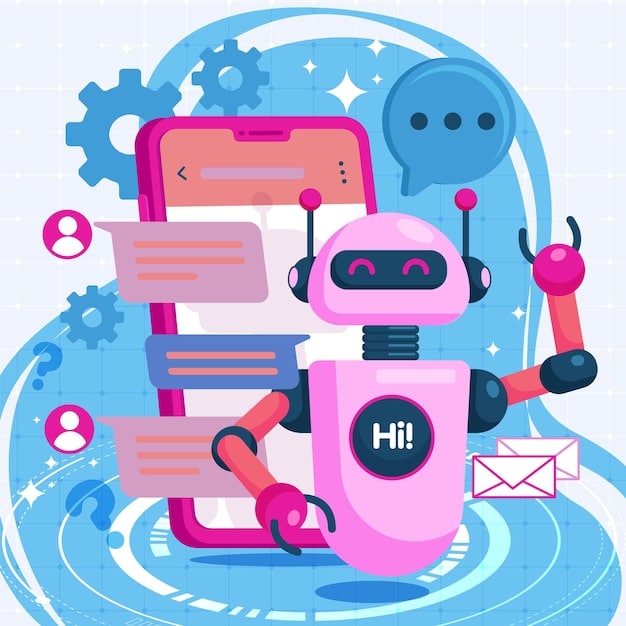Integrate Chatbots: A Step-by-Step Marketing Strategy

Integrating chatbots into your marketing strategy enhances customer engagement by providing instant support, personalized experiences, and efficient communication, streamlining interactions and boosting satisfaction.
Ready to transform your marketing strategy and boost customer engagement? Learn how to integrate chatbots into your marketing strategy for improved customer engagement effectively and efficiently!
Understanding the Power of Chatbots in Marketing
Chatbots have emerged as a powerful tool in the marketing landscape. They provide businesses with a unique opportunity to engage with customers in real-time, offering personalized support and enhancing the overall customer experience.
By understanding the capabilities of chatbots, businesses can leverage them to streamline marketing efforts, improve customer satisfaction, and drive conversions.
Benefits of Using Chatbots
Implementing chatbots offers a myriad of benefits. They can automate repetitive tasks, provide instant customer support, and gather valuable data for improving marketing strategies.
- 24/7 Availability: Chatbots can operate around the clock, ensuring that customers receive assistance at any time, regardless of time zone.
- Cost-Effective Solution: By automating customer interactions, chatbots reduce the need for large customer service teams, cutting operational costs.
- Personalized Customer Experiences: Chatbots can provide personalized recommendations and support based on customer data and preferences.
- Lead Generation: Chatbots can capture leads by engaging visitors, collecting their information, and guiding them through the sales funnel.
Chatbots are not just a technological addition; they are a strategic asset that can significantly impact marketing performance. They assist in personalized communication, enhance customer service, and offer valuable insights for future improvements.

Defining Your Chatbot Strategy
Before integrating chatbots, it’s crucial to define a clear and comprehensive strategy. This involves identifying key objectives, understanding your target audience, and selecting the right chatbot platform.
A well-defined strategy ensures that chatbots align with your marketing goals and provide maximum value to your customers.
Identifying Key Objectives
Defining specific objectives is essential for measuring the success of your chatbot implementation. Objectives might include improving customer satisfaction, generating leads, or reducing customer service costs.
Clearly defined objectives help focus your efforts and provide a benchmark for assessing the chatbot’s performance.
Understanding Your Target Audience
Knowing your audience is fundamental to creating a chatbot that resonates with them. Consider their demographics, preferences, and common pain points.
This understanding will help you tailor the chatbot’s responses and interactions to meet their specific needs.
Choosing the Right Chatbot Platform
Selecting the right chatbot platform is critical for successful implementation. Numerous platforms offer various features and capabilities, so it’s essential to choose one that aligns with your needs and budget.
The chosen platform should offer user-friendly interfaces, customizable options, and seamless integration with existing marketing tools.
- Consider Scalability:Choose a platform that can handle increasing traffic and complex interactions as your business grows.
- Evaluate Integration Capabilities:Ensure the platform integrates seamlessly with your CRM, email marketing tools, and other critical systems.
- Assess Customization Options:Opt for a platform that allows you to customize the chatbot’s design and functionality to match your brand identity.
The choice of platform should be based on a thorough evaluation of your business requirements, technical capabilities, and long-term marketing goals.

Designing Engaging Chatbot Conversations
The design of your chatbot conversations significantly impacts user engagement. Create dialogues that are natural, informative, and aligned with your brand voice.
Engaging conversations keep users interested and encourage them to interact further with the chatbot.
Crafting Natural Language Responses
Develop responses that sound natural and human-like. Avoid overly technical language and use a conversational tone.
Chatbots that understand and respond appropriately to natural language queries provide a more satisfying user experience.
Implementing Personalization Techniques
Personalize conversations by using customer names, referencing past interactions, and offering tailored recommendations.
Personalization makes users feel valued and increases the likelihood of them engaging with the chatbot.
Integrating Chatbots into Different Marketing Channels
Chatbots can be integrated into various marketing channels, including websites, social media platforms, and messaging apps. Each channel offers unique opportunities for engaging with customers.
Integrating chatbots across multiple channels ensures consistent and convenient customer experiences.
- Website Integration:Embed chatbots on your website to provide instant support and guide visitors through the site.
- Social Media Integration:Utilize chatbots on social media platforms to respond to inquiries, run contests, and generate leads.
- Messaging App Integration:Incorporate chatbots into messaging apps like Facebook Messenger and WhatsApp to engage with customers on their preferred channels.
The choice of channel should align with your target audience and the nature of your marketing campaigns. A multichannel approach ensures that customers can interact with your chatbot regardless of their preferred communication method.
Measuring and Optimizing Chatbot Performance
Measuring chatbot performance is essential for identifying areas for improvement. Track key metrics such as customer satisfaction, engagement rates, and conversion rates.
Regularly optimizing chatbot performance ensures that it continues to provide value to your customers and aligns with your marketing goals.
Tracking Key Metrics
Monitor metrics such as customer satisfaction scores, chatbot usage rates, and conversion rates to assess its effectiveness.
These metrics provide insights into the chatbot’s strengths and weaknesses and guide optimization efforts.
Gathering Customer Feedback
Collect feedback from customers about their chatbot experiences. Use surveys, feedback forms, and direct inquiries to gather valuable insights.
Customer feedback provides a direct perspective on what works well and what needs improvement. By analyzing pain points and addressing concerns, you can enhance the chatbot’s usability and overall customer satisfaction.
| Key Point | Brief Description |
|---|---|
| 🤖 Benefits of Chatbots | 24/7 availability, cost-effectiveness, personalized experiences & lead generation. |
| 🎯 Defining Strategy | Identify key objectives and understand your target audience. |
| ⚙️ Choosing Platform | Consider scalability, integration, and customization options. |
| 💬 Conversation Design | Craft natural responses and use personalization techniques. |
FAQ
▼
Chatbots offer 24/7 availability, reduce costs, provide personalized experiences, and generate leads. They ensure customers receive instant support and tailored recommendations, improving satisfaction and driving conversions.
▼
Consider scalability, integration capabilities with existing systems, and customization options. The platform should align with your business requirements, technical capabilities, and long-term marketing goals for optimal chatbot performance.
▼
Craft natural language responses and use personalization techniques. Ensure conversations are human-like, informative, and aligned with your brand voice. Tailor responses to meet specific customer needs for a satisfying user experience.
▼
Track customer satisfaction scores, chatbot usage rates, and conversion rates to assess effectiveness. Use surveys and feedback forms to gather insights. These indicators will guide optimization efforts and enhance chatbot usability.
▼
Chatbots can be integrated across websites, social media platforms, and messaging apps. They provide consistent and convenient customer experiences regardless of the user’s preferred channel, improving engagement and support.
Conclusion
Integrating chatbots into your marketing strategy can significantly improve customer engagement by offering instant support, personalized experiences, and efficient communication. By defining a clear strategy, choosing the right platform, designing engaging conversations, and continuously measuring and optimizing performance, businesses can leverage chatbots to enhance customer satisfaction and achieve their marketing goals.





